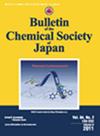Bright Red-color Luminescence from Ag−In−Ga−S-based Quantum Dots with the introduction of Copper
IF 3.8
3区 化学
Q2 CHEMISTRY, MULTIDISCIPLINARY
引用次数: 0
Abstract
This study presents cadmium-free, red-emission quantum dots (QDs) synthesized by incorporating Cu into silver indium gallium sulfide/gallium sulfide (Ag–In–Ga–S/Ga–S) core/shell QDs. By using a previous technique, in which the original Ag–In–Ga–S/Ga–S core/shell QDs exhibiting band-edge photoluminescence (PL) were improved to achieve a narrower emission and facile synthesis, we injected a mixture of Cu and Ag sources into a heated solution containing In, Ga, and S sources. This resulted in the formation of Ag–Cu–In–Ga–S quinary QDs without any precipitation. After being coated with a Ga–S shell, these QDs exhibit a red-colored PL with a spectral full-width at half maximum of 55–60 nm. Although the PL wavelength was responsive to changes in In/Ga ratios, it was unaffected by variations in Cu/Ag ratios due to the transition between conduction band electrons and holes localized at Cu cites. Notably, the electroluminescence device exhibited high-purity red light that satisfies the recommendation ITU-R BT.2020 standard. Cadmium-free Ag–Cu–In–Ga–S/Ga–S core/shell quantum dots were synthesized by a scalable method and red emission was obtained from a free-to-bound transition via Cu-related localized states. The emission wavelength was controlled by the In/Ga ratio, which allowed the fabrication of high-purity red electroluminescence in compliance with the ITU-R BT.2020 standard.引入铜的Ag−In−Ga−基量子点的亮红色发光
本文研究了将Cu加入到银铟硫化镓/硫化镓(Ag-In-Ga-S / Ga-S)核壳量子点中合成的无镉红发射量子点(QDs)。我们利用先前的技术,将原始的Ag - in - Ga - S/Ga - S核/壳量子点改进为具有带边光致发光(PL),以实现更窄的发射和更容易的合成,将Cu和Ag源的混合物注入含有in, Ga和S源的加热溶液中。这导致在没有任何沉淀的情况下形成Ag-Cu-In-Ga-S五量子点。经Ga-S壳层包覆后,这些量子点呈现出红色PL,光谱全宽度最大为55 ~ 60nm。虽然PL波长对in /Ga比的变化有响应,但由于导带电子和Cu城空穴之间的跃迁,它不受Cu/Ag比变化的影响。值得注意的是,该电致发光装置显示出符合ITU-R BT.2020推荐标准的高纯度红光。采用可扩展方法合成了无镉Ag-Cu-In-Ga-S / Ga-S核壳量子点,并通过cu相关局域态在自由键跃迁中获得红色发射。发射波长由In/Ga比值控制,制备出符合ITU-R BT.2020标准的高纯度红色电致发光材料。
本文章由计算机程序翻译,如有差异,请以英文原文为准。
求助全文
约1分钟内获得全文
求助全文
来源期刊
CiteScore
6.40
自引率
5.00%
发文量
194
审稿时长
3-8 weeks
期刊介绍:
The Bulletin of the Chemical Society of Japan (BCSJ) is devoted to the publication of scientific research papers in the fields of Theoretical and Physical Chemistry, Analytical and Inorganic Chemistry, Organic and Biological Chemistry, and Applied and Materials Chemistry. BCSJ appears as a monthly journal online and in advance with three kinds of papers (Accounts, Articles, and Short Articles) describing original research. The purpose of BCSJ is to select and publish the most important papers with the broadest significance to the chemistry community in general. The Chemical Society of Japan hopes all visitors will notice the usefulness of our journal and the abundance of topics, and welcomes more submissions from scientists all over the world.

 求助内容:
求助内容: 应助结果提醒方式:
应助结果提醒方式:


